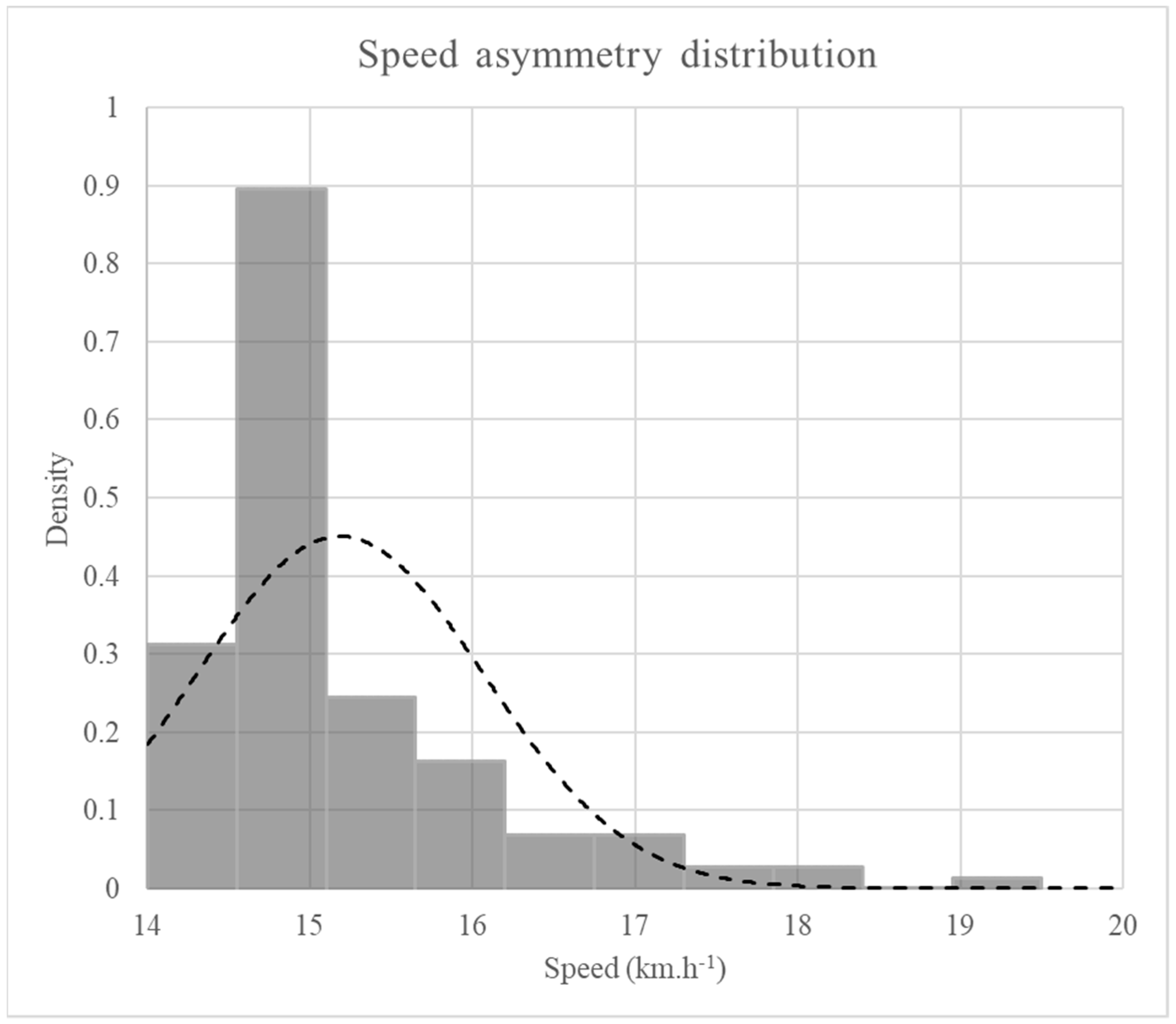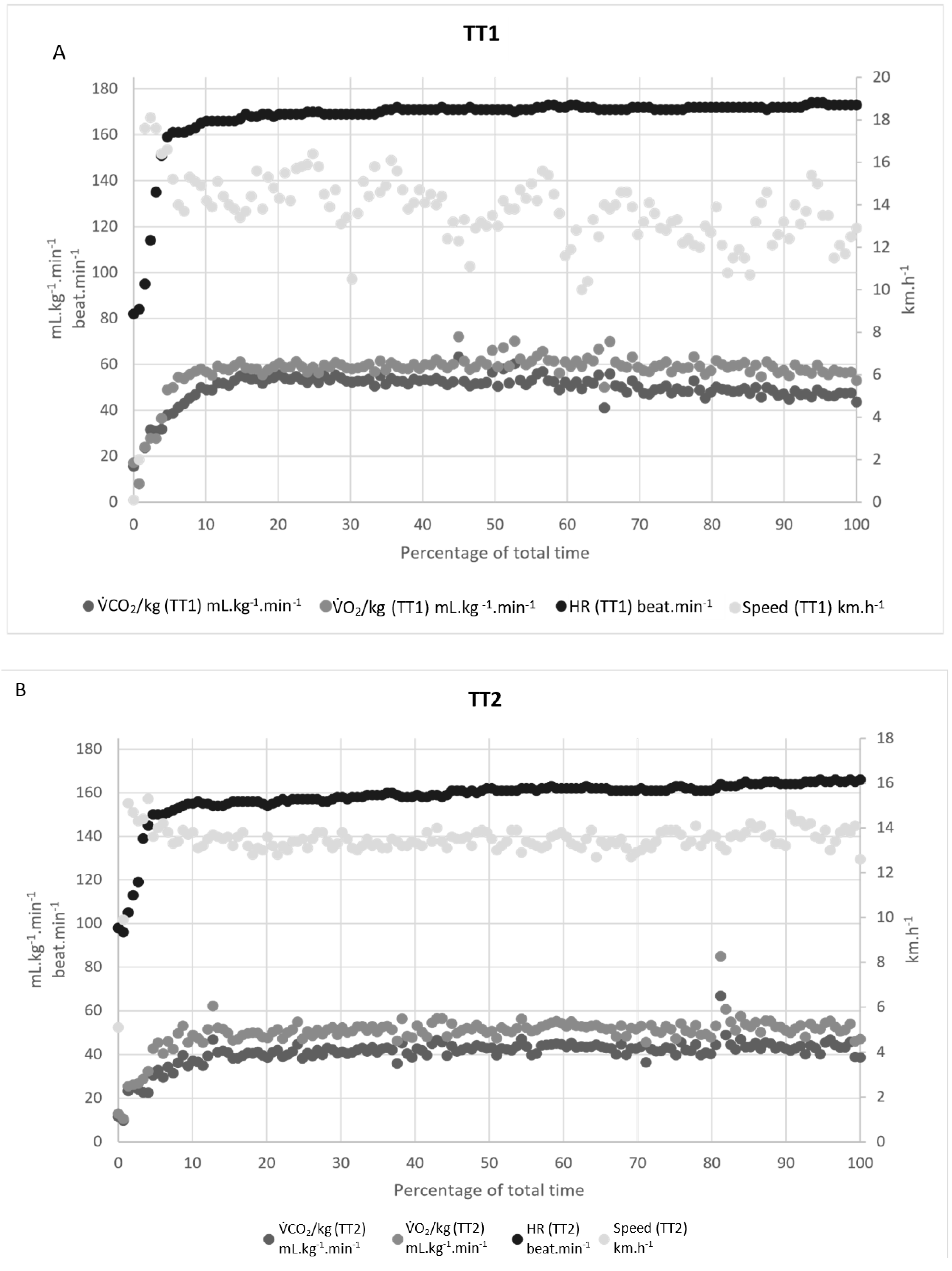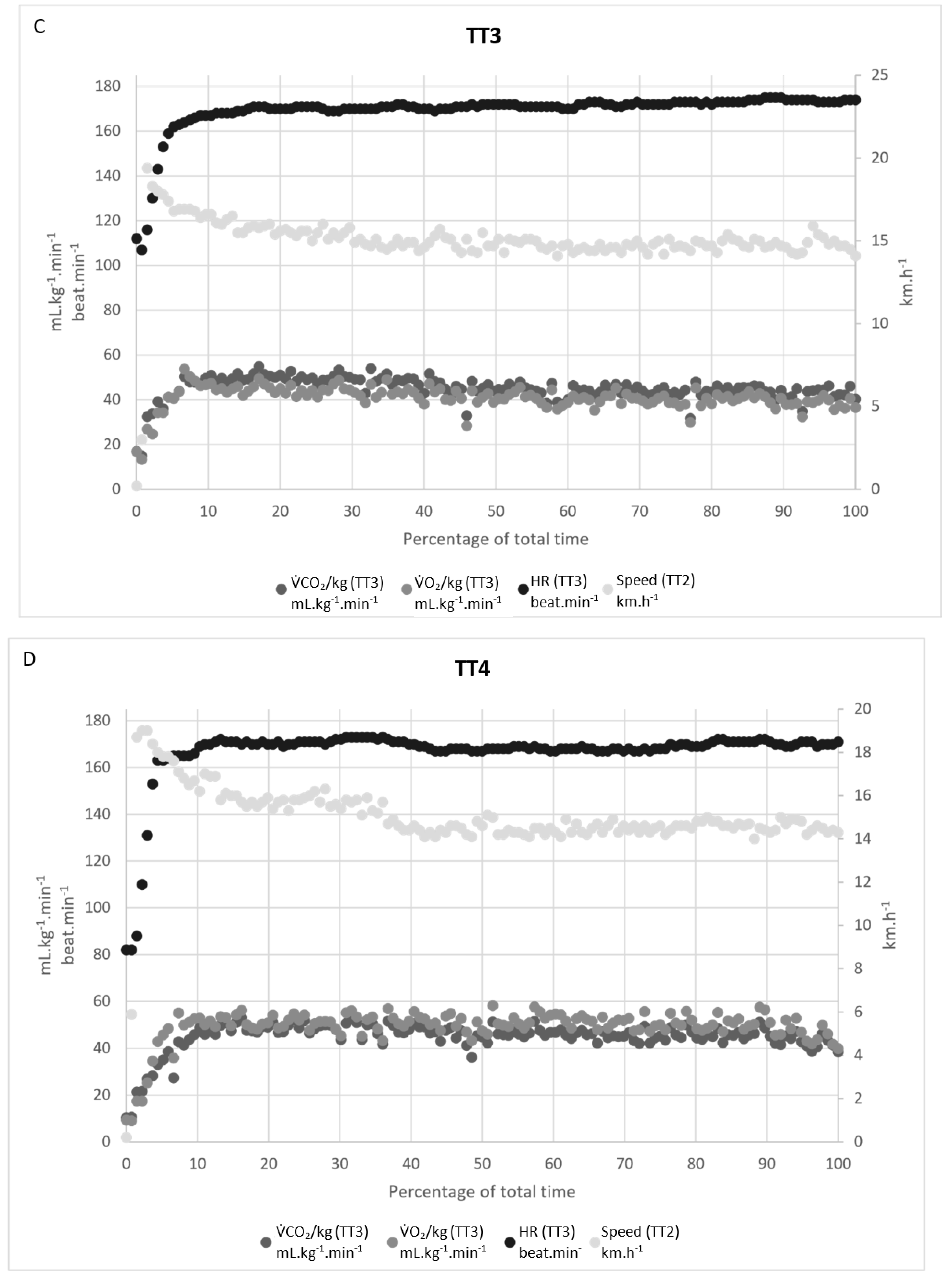Pace Controlled by a Steady-State Physiological Variable Is Associated with Better Performance in a 3000 M Run
Abstract
:1. Introduction
2. Materials and Methods
2.1. Trial Conditions
2.2. Experimental Measurements
2.3. Calculated Variables
2.4. Statistical Analysis
3. Results
3.1. Performance over 3000 m in Each Time Trial
3.2. Physiological Strain: Oxygen and Cardiac Costs
3.3. Statistical Characteristics of Speed Distribution Strategies: Skewness, Coefficient of Variation, and Kendall’s τ
4. Discussion
5. Practical Applications
6. Conclusions
Author Contributions
Funding
Institutional Review Board Statement
Informed Consent Statement
Acknowledgments
Conflicts of Interest
References
- Billat, V.L.; Slawinski, J.; Danel, M.; Koralsztein, J.P. Effect of Free versus Constant Pace on Performance and Oxygen Kinetics in Running. Med. Sci. Sports Exerc. 2001, 33, 2082–2088. [Google Scholar] [CrossRef] [Green Version]
- Foster, C.; Snyder, A.C.; Thompson, N.N.; Green, M.A.; Foley, M.; Schrager, M. Effect of Pacing Strategy on Cycle Time Trial Performance. Med. Sci. Sports Exerc. 1993, 25, 383–388. [Google Scholar] [CrossRef]
- Billat, V.L.; Mille-Hamard, L.; Meyer, Y.; Wesfreid, E. Detection of Changes in the Fractal Scaling of Heart Rate and Speed in a Marathon Race. Phys. Stat. Mech. Appl. 2009, 388, 3798–3808. [Google Scholar] [CrossRef]
- Noakes, T.D. Fatigue Is a Brain-Derived Emotion That Regulates the Exercise Behavior to Ensure the Protection of Whole Body Homeostasis. Front. Physiol. 2012, 3, 82. [Google Scholar] [CrossRef] [PubMed] [Green Version]
- Esteve-Lanao, J.; Lucia, A.; deKoning, J.J.; Foster, C. How Do Humans Control Physiological Strain during Strenuous Endurance Exercise? PLoS ONE 2008, 3, e2943. [Google Scholar] [CrossRef] [PubMed]
- Coquart, J.B.J.; Dufour, Y.; Groslambert, A.; Matran, R.; Garcin, M. Relationships Between Psychological Factors, RPE and Time Limit Estimated by Teleoanticipation. Sport Psychol. 2012, 26, 359–374. [Google Scholar] [CrossRef]
- Gibson, A.S.C.; Noakes, T.D. Evidence for Complex System Integration and Dynamic Neural Regulation of Skeletal Muscle Recruitment during Exercise in Humans. Br. J. Sports Med. 2004, 38, 797–806. [Google Scholar] [CrossRef]
- Ulmer, H.-V. Concept of an Extracellular Regulation of Muscular Metabolic Rate during Heavy Exercise in Humans by Psychophysiological Feedback. Experientia 1996, 52, 416–420. [Google Scholar] [CrossRef]
- Noakes, T.D.; Gibson, A.S.C.; Lambert, E.V. From Catastrophe to Complexity: A Novel Model of Integrative Central Neural Regulation of Effort and Fatigue during Exercise in Humans: Summary and Conclusions. Br. J. Sports Med. 2005, 39, 120–124. [Google Scholar] [CrossRef] [PubMed] [Green Version]
- Fukuba, Y.; Whipp, B.J. A Metabolic Limit on the Ability to Make up for Lost Time in Endurance Events. J. Appl. Physiol. 1999, 87, 853–861. [Google Scholar] [CrossRef] [PubMed]
- Billat, V.; Carbillet, T.; Correa, M.; Pycke, J.-R. Detecting the Marathon Asymmetry with a Statistical Signature. Phys. Stat. Mech. Appl. 2019, 515, 240–247. [Google Scholar] [CrossRef]
- Perez-Suarez, I.; Martin-Rincon, M.; Gonzalez-Henriquez, J.J.; Fezzardi, C.; Perez-Regalado, S.; Galvan-Alvarez, V.; Juan-Habib, J.W.; Morales-Alamo, D.; Calbet, J.A.L. Accuracy and Precision of the COSMED K5 Portable Analyser. Front. Physiol. 2018, 9. [Google Scholar] [CrossRef]
- Boudet, G.; Albuisson, E.; Bedu, M.; Chamoux, A. Heart Rate Running Speed Relationships During Exhaustive Bouts in the Laboratory. Can. J. Appl. Physiol. 2004, 29, 731–742. [Google Scholar] [CrossRef] [PubMed]
- Cooper, K.H. A Means of Assessing Maximal Oxygen Intake: Correlation between Field and Treadmill Testing. JAMA 1968, 203, 201–204. [Google Scholar] [CrossRef]
- Katch, F.I.; Pechar, G.S.; McArdle, W.D.; Weltman, A.L. Relationship between Individual Differences in a Steady Pace Endurance Running Performance and Maximal Oxygen Intake. Res. Q. 1973, 44, 206–215. [Google Scholar] [CrossRef]
- Marino, F.E. The Limitations of the Constant Load and Self-Paced Exercise Models of Exercise Physiology. Comp. Exerc. Physiol. 2012, 8, 3–9. [Google Scholar] [CrossRef]
- Bath, D.; Turner, L.A.; Bosch, A.N.; Tucker, R.; Lambert, E.V.; Thompson, K.G.; Gibson, A.S.C. The Effect of a Second Runner on Pacing Strategy and RPE During a Running Time Trial. Int. J. Sports Physiol. Perform. 2012, 7, 26–32. [Google Scholar] [CrossRef] [PubMed] [Green Version]
- Konings, M.J.; Schoenmakers, P.P.J.M.; Walker, A.J.; Hettinga, F.J. The Behavior of an Opponent Alters Pacing Decisions in 4-Km Cycling Time Trials. Physiol. Behav. 2016, 158, 1–5. [Google Scholar] [CrossRef] [Green Version]
- Hettinga, F.J.; Konings, M.J.; Pepping, G.-J. The Science of Racing against Opponents: Affordance Competition and the Regulation of Exercise Intensity in Head-to-Head Competition. Front. Physiol. 2017, 8. [Google Scholar] [CrossRef] [PubMed] [Green Version]
- Thiel, C.; Foster, C.; Banzer, W.; Koning, J.D. Pacing in Olympic Track Races: Competitive Tactics versus Best Performance Strategy. J. Sports Sci. 2012, 30, 1107–1115. [Google Scholar] [CrossRef] [Green Version]
- Billat, V.L.; Wesfreid, E.; Kapfer, C.; Koralsztein, J.P.; Meyer, Y. Nonlinear Dynamics of Heart Rate and Oxygen Uptake in Exhaustive 10,000 m Runs: Influence of Constant vs. Freely Paced. J. Physiol. Sci. JPS 2006, 56, 103–111. [Google Scholar] [CrossRef] [Green Version]
- Coquart, J.B.J.; Garcin, M. Validité et Fiabilité Des Balances Basées Sur La Perception Lors de Courses Épuisantes Chez Des Coureurs Masculins Entraînés. Percept. Mot. Skills 2007, 104, 254–266. [Google Scholar] [CrossRef] [PubMed]
- Foster, C.; deKoning, J.J.; Hettinga, F.; Lampen, J.; Dodge, C.; Bobbert, M.; Porcari, J.P. Effect of Competitive Distance on Energy Expenditure During Simulated Competition. Int. J. Sports Med. 2004, 25, 198–204. [Google Scholar] [CrossRef]
- Townsend, M.A. Road-Racing Strategies. Med. Sci. Sports Exerc. 1982, 14, 235–243. [Google Scholar] [CrossRef]
- Billat, V.; Demarle, A.; Paiva, M.; Koralsztein, J.P. Effect of Training on the Physiological Factors of Performance in Elite Marathon Runners (Males and Females). Int. J. Sports Med. 2002, 23, 336–341. [Google Scholar] [CrossRef] [PubMed]
- HANEY, T.A.; MERCER, J.A. A Description of Variability of Pacing in Marathon Distance Running. Int. J. Exerc. Sci. 2011, 4, 133–140. [Google Scholar] [PubMed]
- Lambert, M.I.; Dugas, J.P.; Kirkman, M.C.; Mokone, G.G.; Waldeck, M.R. Changes in Running Speeds in a 100 KM Ultra-Marathon Race. J. Sports Sci. Med. 2004, 3, 167–173. [Google Scholar] [PubMed]
- Carbillet, T. Monitoring en Temps Réel de la Vitesse de Déplacement sur Dispositif Connecté: Modélisation Mathématique sur Plateforme Mobile Interfacée Avec une Base de Données D’entraînement et D’audit Physiologique. Available online: https://tel.archives-ouvertes.fr/tel-02269138 (accessed on 16 June 2021).
- Maron, M.B.; Horvath, S.M.; Wilkerson, J.E.; Gliner, J.A. Oxygen Uptake Measurements during Competitive Marathon Running. J. Appl. Physiol. 1976, 40, 836–838. [Google Scholar] [CrossRef]
- Duffield, R.; Dawson, B. Energy System Contribution in Track Running. New Stud. Athl. (IAAF) 2003, 18, 47–56. [Google Scholar]
- Thomas, C.; Hanon, C.; Perrey, S.; Chevalier, J.-M.L.; Couturier, A.; Vandewalle, H. Oxygen Uptake Response to an 800-m Running Race. Int. J. Sports Med. 2005, 26, 268–273. [Google Scholar] [CrossRef] [PubMed]
- Hanon, C.; Leveque, J.-M.; Thomas, C.; Vivier, L. Pacing Strategy and V·O2 Kinetics during a 1500-m Race. Int. J. Sports Med. 2008, 29, 206–211. [Google Scholar] [CrossRef]
- Prampero, P.E.; Francescato, M.P.; Cettolo, V. Energetics of Muscular Exercise at Work Onset: The Steady-State Approach. Pflug. Arch. 2003, 445, 741–746. [Google Scholar] [CrossRef]
- Jones, A.M.; Burnley, M.; Black, M.I.; Poole, D.C.; Vanhatalo, A. The Maximal Metabolic Steady State: Redefining the ‘Gold Standard’. Physiol. Rep. 2019, 7, e14098. [Google Scholar] [CrossRef] [PubMed] [Green Version]
- di Prampero, P.E. The Energy Cost of Human Locomotion on Land and in Water. Int. J. Sports Med. 1986, 7, 55–72. [Google Scholar] [CrossRef] [PubMed]
- Billat, V.L.; Petot, H.; Landrain, M.; Meilland, R.; Koralsztein, J.P.; Mille-Hamard, L. Cardiac Output and Performance during a Marathon Race in Middle-Aged Recreational Runners. Available online: https://www.hindawi.com/journals/tswj/2012/810859/abs/ (accessed on 5 August 2019).
- Ferretti, G.; Fagoni, N.; Taboni, A.; Bruseghini, P.; Vinetti, G. The Physiology of Submaximal Exercise: The Steady State Concept. Respir. Physiol. Neurobiol. 2017, 246, 76–85. [Google Scholar] [CrossRef] [PubMed]
- Poole, D.C.; Ward, S.A.; Gardner, G.W.; Whipp, B.J. Metabolic and Respiratory Profile of the Upper Limit for Prolonged Exercise in Man. Ergonomics 1988, 31, 1265–1279. [Google Scholar] [CrossRef] [PubMed]
- Whipp, B.J. The Slow Component of O2 Uptake Kinetics during Heavy Exercise. Med. Sci. Sports Exerc. 1994, 26, 1319–1326. [Google Scholar] [CrossRef]
- Craig, J.C.; Vanhatalo, A.; Burnley, M.; Jones, A.M.; Poole, D.C. Chapter 8—Critical Power: Possibly the Most Important Fatigue Threshold in Exercise Physiology. In Muscle and Exercise Physiology; Zoladz, J.A., Ed.; Academic Press: Cambridge, MA, USA, 2019; Chapter 8; pp. 159–181. ISBN 978-0-12-814593-7. [Google Scholar]
- Jones, A.M.; Whipp, B.J. Bioenergetic Constraints on Tactical Decision Making in Middle Distance Running. Br. J. Sports Med. 2002, 36, 102–104. [Google Scholar] [CrossRef] [PubMed] [Green Version]
- Skiba, P.F.; Jones, A.M. Implications of the Critical Speed and Slow Component of Vo2 for the 2-Hour Marathon. J. Appl. Physiol. Bethesda Md 2011, 110, 280; discussion 294. [Google Scholar] [CrossRef]



| Trial | Race Time (s) | Percentage Time Spent Below Average Speed | Oxygen Cost (mLO2·kg−1·m−1) | Cardiac Cost (m−1·Beat) |
|---|---|---|---|---|
| 3000 m, freely paced (TT1) | 853.6 ± 52.5 | 51.9 ± 3.8 | 0.31 ± 0.05 | 1.17 ± 0.11 |
| 3000 m, steady-state speed (TT2) | 798.5 ± 60.4 | 57.1 ± 6.6 a | 0.22 ± 0.03 a | 1.45 ± 0.12 a |
| 3000 m, steady-state O2 (TT3) | 739.7 ± 34.2 a | 64.5 ± 8.3 a | 0.20 ± 0.05 a | 1.46 ± 0.15 a |
| 3000 m, steady-state HR (TT4) | 747.9 ± 32.6 a | 61.1 ± 6.0 a | 0.22 ± 0.03 a | 1.45 ± 0.09 a |
Publisher’s Note: MDPI stays neutral with regard to jurisdictional claims in published maps and institutional affiliations. |
© 2021 by the authors. Licensee MDPI, Basel, Switzerland. This article is an open access article distributed under the terms and conditions of the Creative Commons Attribution (CC BY) license (https://creativecommons.org/licenses/by/4.0/).
Share and Cite
Molinari, C.A.; Bresson, P.; Palacin, F.; Billat, V. Pace Controlled by a Steady-State Physiological Variable Is Associated with Better Performance in a 3000 M Run. Int. J. Environ. Res. Public Health 2021, 18, 7886. https://doi.org/10.3390/ijerph18157886
Molinari CA, Bresson P, Palacin F, Billat V. Pace Controlled by a Steady-State Physiological Variable Is Associated with Better Performance in a 3000 M Run. International Journal of Environmental Research and Public Health. 2021; 18(15):7886. https://doi.org/10.3390/ijerph18157886
Chicago/Turabian StyleMolinari, Claire A., Pierre Bresson, Florent Palacin, and Véronique Billat. 2021. "Pace Controlled by a Steady-State Physiological Variable Is Associated with Better Performance in a 3000 M Run" International Journal of Environmental Research and Public Health 18, no. 15: 7886. https://doi.org/10.3390/ijerph18157886
APA StyleMolinari, C. A., Bresson, P., Palacin, F., & Billat, V. (2021). Pace Controlled by a Steady-State Physiological Variable Is Associated with Better Performance in a 3000 M Run. International Journal of Environmental Research and Public Health, 18(15), 7886. https://doi.org/10.3390/ijerph18157886







